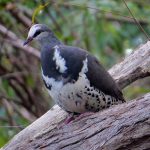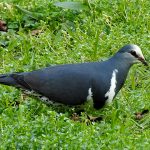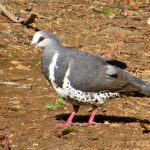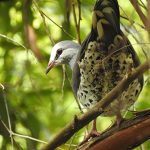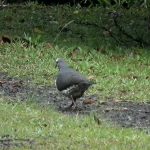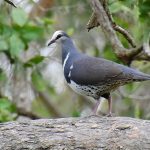WONGA PIGEON
The Wonga Pigeon – Australia’s Elegant Forest Dweller
The Wonga Pigeon is a bird that captivates with its distinctive and refined plumage. Adorned with an intricate mosaic of black and white, it stands out in the avian world with a quiet poise. The glossy black cloak of its upper body contrasts sharply with the pristine white of its underparts, belly, and tail, the division marked by delicate speckling that almost resembles a scattering of raindrops. This striking combination of colours makes the Wonga Pigeon one of the most eye-catching members of Australia’s pigeon family.
With a solid frame measuring 40–45 centimetres in length, this species ranks among the largest pigeons in Australia. Its body is sturdy, its legs strong, and its wings broad – all features that serve it well when navigating the dense forest understorey. Yet, despite its size, the Wonga Pigeon is surprisingly elusive, often melting into the shadows with graceful ease.
The Voice of the Forest
Renowned for its deep, rhythmic calls – a measured series of “coo… coo… coo…” – the Wonga Pigeon’s voice carries across the stillness of the forest floor. These calls are most often heard at dawn and dusk, resonating through the undergrowth like a slow heartbeat. They serve multiple purposes:
- Courtship – drawing the attention of potential mates.
- Territorial signals – letting other pigeons know an area is already claimed.
- Contact calls – maintaining communication between mates.
Preferred Home and Habitat
Wonga Pigeons favour subtropical and temperate rainforests, as well as moist eucalypt forests along Australia’s eastern seaboard, from south-east Queensland through New South Wales and into eastern Victoria. They seldom venture far from freshwater sources, relying on the shelter of dense undergrowth like ferns, vines, and shrubs to remain hidden from predators. Interestingly, they are ground-dwelling pigeons, spending much of their time walking slowly along the forest floor in search of food.
Feeding Habits and Ecological Role
Primarily frugivorous, Wonga Pigeons feed on fallen fruits from native trees such as lilly pillies, figs, and quandongs. They also consume seeds and the occasional insect. This diet makes them important seed dispersers, helping replenish and regenerate forest vegetation. In this way, they act as quiet gardeners of the bush, ensuring plant diversity continues to thrive.
Courtship and Breeding
The breeding season, often from October to January, unveils the Wonga Pigeon’s gentle courtship rituals. Males bow and fan their tails while calling softly, their plumage catching dappled sunlight through the canopy. Nest construction is a joint effort, with both parents gathering sticks and twigs to create a simple yet sturdy platform hidden among tree branches.
- Clutch size: Usually one creamy white egg.
- Incubation: Around 17 days, shared equally by both parents.
- Chick development: Young pigeons are fed on a nutrient-rich substance called “pigeon milk”, produced in the parents’ crop.
Fascinating Facts about the Wonga Pigeon
- Name origin – The name “Wonga” is believed to be derived from an Aboriginal word imitating its call.
- Lifespan – In the wild, they can live up to 10 years, though predation shortens this for many individuals.
- Shy but persistent – Though they prefer to remain hidden, Wonga Pigeons will quietly return to the same feeding spots year after year.
- Ground foragers – Unlike many pigeons that feed in the trees, Wonga Pigeons collect most of their food from the forest floor.
- Historic decline – They were once hunted extensively for food in colonial times, which caused a significant decline in some regions.
- Role in forests – By swallowing fruits whole, they carry seeds considerable distances before depositing them in new locations through droppings.
Conservation
Wonga Pigeons remain relatively common in suitable habitats, but they face ongoing threats:
- Predation from introduced species like cats, dogs and foxes.
- Habitat loss from land clearing and fragmentation.
- Road collisions, as they often feed close to the ground near forest edges.
Protecting mature forests and restoring degraded areas is vital for the long-term survival of this species. By safeguarding the habitats they depend on, we not only protect the pigeons themselves but also the forests they help sustain.
The Wonga Pigeon is more than just a beautiful bird; it is a key player in maintaining healthy forest ecosystems. Its soft calls, secretive movements, and ecological work as a seed disperser make it an understated yet essential part of Australia’s natural heritage. To encounter one, whether in sight or sound, is to be reminded of the quiet, intricate rhythms of the bush – rhythms worth protecting for generations to come.

